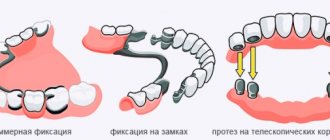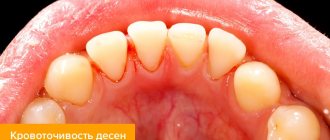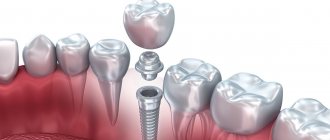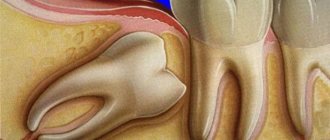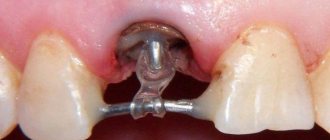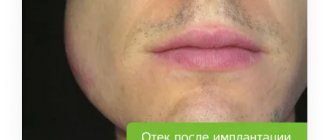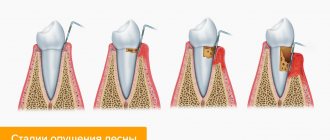Causes Symptoms Treatment Possible complications Prevention
Gum hyperplasia is a condition in which tissue begins to grow excessively. They hang over the teeth, forming false pockets, covering most of them, interfering with hygiene procedures. There are several terms in the literature that describe this condition: gingival overgrowth, hypertrophy, or hypertrophic gingivitis.
The main danger of tissue proliferation is that it promotes the proliferation of bacteria, causing serious diseases such as periodontitis.
Causes of gum hypertrophy
The main reason for tissue hypertrophy in the mouth is poor hygiene. Remains of food and decay products settle on the enamel of the teeth. They accumulate, causing inflammation of the mucous membrane, one of the manifestations of which is hyperplasia.
Other reasons include:
- Taking certain medications
A side effect of some anticonvulsants and immunosuppressants, and some heart medications, is gum overgrowth. However, you should not stop taking them or reduce the dosage if your gums have increased in size and began to bleed, without consulting a doctor.
- Genetic predisposition
Most people experience tissue growth during puberty. In most cases, after the end of hormonal changes, spontaneous reduction is observed. But in some patients, the gums do not shrink and may even increase in size. This phenomenon is characteristic of hereditary fibromatosis.
- General diseases
Leukemia almost always provokes tissue hypertrophy because they are saturated with dense masses of immature leukocytes. The gum turns into a hard surface on which wounds appear at the slightest pressure. This problem is also typical for sarcoidosis.
- Hormonal instability
Pregnancy and diseases of the endocrine system, such as diabetes or hypothyroidism, disrupt metabolic processes in tissues and lead to inadequate growth.
- Crowded teeth
If teeth creep onto each other and overlap surfaces, this interferes with proper cleaning of surfaces and contributes to the formation of microbial plaques. They, in turn, provoke inflammation.
Plastic surgery for gum recession
There are some periodontal diseases that cause gum recession. This is a condition in which the gum tissue shrinks and exposes the root of the tooth, which not only looks unsightly, but can also lead to many problems and even tooth loss. Recession can occur on one tooth or on several.
A too short and powerful frenulum or insufficient vestibule of the oral cavity, as well as some periodontal diseases, contribute to the detachment of the free edge of the gums, the formation of gum pockets, and inflammation. Vestibuloplasty can avoid this. This operation is performed in the vestibule of the oral cavity to deepen it and more rationally distribute soft tissue in this area.
In order to return the gum tissue to the required volume, cover exposed roots, prevent root caries and generally improve the aesthetics of a smile, gum augmentation is also performed. Depending on the situation, only connective tissue and epithelium can be built up, or maybe together with the periosteum. In the first case, such a flap is called split, in the second - complete.
Symptoms
The growth of the mucous membrane is a gradual process. There are 3 degrees:
- The gingival papillae increase in volume. The gingival contour is disrupted and hangs over the tooth.
- The growth progresses, the tissue covers up to half of the coronal part. Bleeding and discomfort when brushing teeth and eating food develop.
- The gum covers the tooth by two thirds, sometimes completely. Folds form in which microflora accumulate, causing inflammation.
The process is generalized
when the entire gum on the jaw suffers.
Focal
hyperplasia is located around one or more teeth.
The edematous form is characterized by the presence of plaque, there is a lot of it, it is quite soft, but covers the enamel with a thick layer. Gum pockets form. The papillae turn red and bleed when pressed.
Patients complain of itching, discomfort in the mouth while eating, and an unpleasant odor.
With fibrous gingival hyperplasia, patients are only concerned about the unusual appearance of the mucous membrane. There is usually no pain or bleeding, but there are complaints of an unpleasant odor.
How gums heal after plastic surgery
Depending on the nature of the operation, gum tissue is restored within a period of several days to several weeks. The doctor provides you with a list of recommendations that must be followed for a speedy recovery. You will also be prescribed anesthetics.
In the postoperative period, physical activity and hard, too hot or cold foods are contraindicated. We'll have to forget about spicy dishes for a while. Of course, standard daily hygiene procedures cannot be ignored. Until the tissues have completely healed, it is recommended to wear a special mouth guard.
Tissue swelling after plastic surgery persists for several days, but, as a rule, it subsides after the third day. If this does not happen, and in addition headaches, bleeding and other suspicious symptoms occur, you should contact your dentist as soon as possible.
Gum grafting is a surgical procedure with its share of risks. The most common ones include an allergic reaction to painkillers and relapse of gum recession. In the first case, you should warn the specialist in advance about a possible allergy; in the second, you will need to repeat the procedure after six months.
Treatment of gum hyperplasia
Any medical intervention is preceded by diagnosis. The clinic conducts a visual examination using dental instruments. An X-ray is taken and, in some cases, a tissue biopsy. Collect information about current diseases and what medications the patient is taking.
Gingival hypertrophy is differentiated from papillomas, granulomas, epulis (neoplasms) or swelling of the gums as a result of periodontitis.
The treatment plan is drawn up taking into account the degree, course and reasons for which the gums have grown.
For concomitant diseases, procedures should be agreed with the attending physician. Sometimes, simply changing the drug leads to a reduction in overgrown tissue.
Therapeutic methods
They are used mainly after replacing the drugs that caused hyperplasia.
- Decoctions and applications
from oak bark, chamomile, St. John's wort, calendula. Tannins in these plants narrow and strengthen the walls of blood vessels, reducing their permeability. As a result of combining with proteins, tannins form an insoluble film on the mucous membrane. This protects nerve endings from breakdown products and reduces pain.
- Installations in gum pockets.
Plant-based preparations are placed in pockets for 15-20 minutes, for up to 3 weeks.
- Dorsenval therapy.
After the elimination of the inflammatory process, physiotherapy is carried out to strengthen blood vessels.
The main treatment measure is professional teeth cleaning.
If the effect of the procedures is insignificant, as well as with fibrous hyperplasia, gingivectomy
.
Surgery
In cases where the gum has grown on the tooth so much that it covers half of the surface or more, the excess tissue is removed. For fibrosis, therapeutic treatment is not used at all; in other cases, the decision depends on the clinical picture.
The operation is performed under local anesthesia. Apply:
- Classic way
. The tissue is excised with a scalpel. The surface of the roots is polished with instruments, and the wound is treated with an antiseptic. Finally, a special bandage is applied (septopak, vokopak). - Laser
removal of overgrown gums . This is a minimally invasive operation, after which healing occurs much faster. During surgery, the vessels are sealed with a laser beam, which eliminates bleeding. At the same time, pathogenic flora is destroyed. Complications after such operations are extremely rare.
Technologies for gum correction before prosthetics
The choice of correction technology depends on the types of prostheses installed by the dentist for the patient. When installing a removable structure, the need for aesthetic plastic surgery of the gingival margin is eliminated due to the structure of the removable prosthesis, which consists not only of crowns, but also of artificial gum, replacing the natural one.
When installing fixed structures that do not have an artificial part, there will be a need for surgery to correct the natural gingival margin. The procedure can be carried out in three different ways.
- Gingivectomy - A surgical procedure aimed at removing part of the gum margin. The procedure is accompanied by the administration of an anesthetic. A specialist uses a surgical instrument (scalpel) to cut off a piece of mucous membrane.
- Gingivoplasty is a more complex surgical procedure that involves, in addition to excision of soft tissue, cleaning the pockets from microorganisms and purulent discharge. To do this, the gums are removed to the base of the tooth.
- Vestibulloplasty is the process of augmenting the missing part of the gum. The procedure consists of dissection, length correction and alignment of the gingival contour.
The above operations are carried out before prosthetics, usually using a surgical scalpel or laser. As a result, the patient receives a beautiful smile not only with new teeth, but also with new gums.
Complications
Hyperplasia is dangerous because without treatment it provokes inflammatory processes in the periodontium: gingivitis and periodontitis. This leads to loosening of teeth and their loss.
Due to the fact that it is impossible to clean teeth well, caries often develops. Enamel demineralization occurs. Metabolic processes are disrupted.
Due to increased sensitivity, patients try not to chew on the side where the gum has grown. The chewing load is distributed unevenly, and the risk of losing teeth increases.
Indications for surgery
Formation of periodontal pockets
Lack of high-quality oral hygiene, improperly performed prosthetics or dental treatment often cause disruption of the periodontal ligaments and penetration of pathogenic microflora deep into the periodontium. As a result, deep periodontal pockets are formed, in which food debris accumulates and dental plaque settles.
The pathology is manifested by bleeding, soreness and swelling of the gums. In this case, gingivectomy is prescribed in advanced situations (moderate and severe periodontitis), when other treatment methods (professional hygiene, curettage, anti-inflammatory drug therapy) have not given a positive result.
During the procedure, necrotic tissue is removed in order to reduce periodontal pockets and prevent the spread of the infectious process to bone structures .
Gum hyperplasia
Pathological growth of the gum mucosa or hyperplasia occurs for various reasons: against the background of hormonal imbalance, chronic injury or inflammatory process. It is characterized by an increase in the volume of the gums, raising the gingival margin to the surface of the teeth, and filling the interdental spaces with gingival tissue.
Gingivectomy is prescribed if conservative treatment aimed at eliminating the causes of the disease is unsuccessful. Allows you to remove excess tissue and restore the aesthetics of your smile.
Prevention
Simple measures will help prevent gum overgrowth. Dentists recommend brushing your teeth with a soft brush, using dental floss or interdental brushes. Using a rinse aid reduces the number of bacteria settling on the enamel. But all these measures will not help if there is plaque on the teeth. Therefore, professional teeth cleaning in dentistry is where the prevention of hyperplasia begins.
Author of the article Voznyuk Vladimir Aleksandrovich Maxillofacial surgeon-implantologist of the highest category
Work experience: 28 years.
Gum plastic surgery during implantation
Gumplasty is performed when the root is exposed, after tooth implantation. Often the need for this operation arises when an implant is installed in place of a long-missing tooth. In this case, the correct gum line is not only aesthetic. It protects the implant from infection and the development of peri-implantitis, which without proper treatment can lead to the loss of the entire structure. In addition, it allows you to prevent further exposure of the roots, reduce tooth hypersensitivity, reduce the likelihood of root destruction and, of course, improve the aesthetics of your smile.
